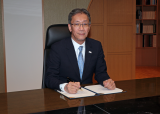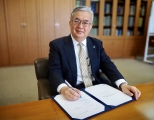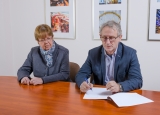KEK, UTokyo and NCBJ Sign MoU to Promote Hyper-Kamiokande Project
11-02-2022
National Centre for Nuclear Research (NCBJ) in Poland, KEK and UTokyo Sign MoU to Promote Hyper-Kamiokande Project
Joint communication
National Centre for Nuclear Research (NCBJ) in Poland, High Energy Accelerator Research Organization (KEK) and The University of Tokyo ( UTokyo) signed a memorandum of understanding (MoU) until the end of January in 2022, which aimed to promote the Hyper-Kamiokande international scientific research project, whose main detector has been under construction toward starting operation in 2027 at Kamioka, Hida- city, Gifu-prefecture in Japan. Ninety countries showed their interest in participating in this Japan-led project and Poland is the first nation to sign MoU.
UTokyo President Teruo Fujii, KEK Director General Masanori Yamauchi and NCBJ Direcor Krzysztof Kurek exchanged signatures by post, due to a quasi-state of emergency declared by the Japanese government to stem the COVID-19 pandemic.
According to the MoU, the Polish Hyper-Kamiokande Consortium has been organized by nine institutions; Institute of Nuclear Physics Polish Academy of Sciences, University of Silesia, National Centre for Nuclear Research (NCBJ), Warsaw University of Technology, University of Warsaw, University of Wrocław, AGH University of Science and Technology, Jagiellonian University, Nicolaus Copernicus Astronomical Center of the Polish Academy of Sciences. Development, production, and installation of a linear electron accelerator, composite photosensor modules, electronics circuit modules, etc. are among their foreseen contributions.
The Hyper-Kamiokande detector is planned to have a fiducial mass eight times larger than its predecessor detector, Super-Kamiokande, and it is equipped with newly-developed high-sensitivity photosensors. The aim of the project is to elucidate the Grand Unified Theory and the history of the evolution of the universe through an investigation of proton decay and CP violation (the asymmetry between neutrinos and antineutrinos), together with the observation of neutrinos from supernova explosions. The budget of the construction was approved in the Japanese Diet in February 2020, which marked the official start of the project. The construction has gotten into full swing with the access tunnel excavation for the experimental site which started in May 2021.
Statement by Ewa Rondio, PhD, Professor, NCBJ Deputy Director for Research, managing the Hyper-Kamiokande project at NCBJ
The teams involved in the Hyper-Kamiokande project have been cooperating with Japanese teams for many years on the T2K and Super-Kamiokande projects. Neutrino research in Japan has led to two Nobel Prize-winning achievements: the observation of neutrinos from astrophysical sources, and then the discovery of the phenomenon of neutrino oscillation. The first of these awards in 2002 went to Raymond Davis Jr. (USA) and Masatoshi Koshiba (Japan) for detecting cosmic neutrinos. The observation was made of neutrinos from the Sun and a supernova explosion in the Kamiokande detector. The second in 2015 was given to Japanese Takaaki Kajita and Canadian Arthur B. McDonald, who discovered the neutrino oscillation. Professor T. Kajita worked in the Super-Kamiokande experiment, and now he is the coordinator of the team involved in the construction of Hyper-Kamiokande (third generation) at Tokyo University. Observation of the neutrino oscillation phenomenon proves that neutrinos have a non-zero rest mass, which is very important for our ideas about the elementary components of matter and their interactions.
By participating in the preparation of the next generation experiment, Hyper-Kamiokande, we are taking part in a very ambitious project that uses the latest technologies to achieve great precision of planned measurements. The Hyper-Kamiokande project has been approved on the Polish Road Map for Research Infrastructures.
The planned participation of the Polish consortium in the construction of the experiment, and then in the measurement and preparation of the results, gives the opportunity to develop modern, very sensitive light detectors and electronics required for their operation. Several hundred photodetectors will be built at the Warsaw University of Technology and CAMK, and systems for reading their data will also be created in Krakow at the Jagiellonian University and AGH. The construction of Hyper-Kamiokande elements also requires the participation of Polish industry.
On the other hand, NCBJ will develop an electron accelerator dedicated to precise calibration of the detector along with the beam guidance line. In this task, experience will be used in the construction of electron accelerators in Świerk, delivered, inter alia, to CERN. Our team will be responsible for this important element of calibration also during data collection.







